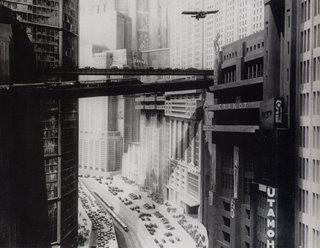The Shrinking City On A Hill
 Youngstown, Ohio has a similar to problem to New Orleans - no, 80% of Youngstown didn't flood - in that it has a shinking population and therefore the city must shrink in size. There the similarities end.
Youngstown, Ohio has a similar to problem to New Orleans - no, 80% of Youngstown didn't flood - in that it has a shinking population and therefore the city must shrink in size. There the similarities end.
For one, Youngstown decline has occured over time with people choosing to live elsewhere. In New Orleans, people were forced to move away overnight and most still wish to return. That doesn't mean that we can't learn from Youngstown's study of how to deal with it's steady decline.
Last year Youngstown 2010--a partnership between the city's planning department and Youngstown State University--unveiled a comprehensive plan to reduce nonessential infrastructure, attract new businesses, and rehab deteriorated and abandoned spaces. In fact Youngstown is the first city in the United States to adopt this disarming approach to the problems of population decline. "It's politically and professionally uncomfortable to face the shrinkage of a city or region, even though it may be staring you in the face," says Frank Popper, an urban-planning professor at Rutgers and Princeton universities. "I think it's enormously brave and creative and innovative of Youngstown to be taking on this task."One of the city's conclusions was to recast itself.
But if Youngstown's residents don't need housing, people from neighboring regions do. Ultimately the city may have to surrender to its location and become a bedroom community for Cleveland and Pittsburgh, each about 70 miles away. So in the end growing smaller may transform Youngstown into something else, says Charles Waldheim, a University of Toronto architecture professor who participated in the most recent Shrinking Cities conference. "To the extent that northeastern Ohio has a market for housing," he says, "it seems that Youngstown's future is making itself available for the garden living of the suburb."New Orleans problem is the opposite. A majority of the city's housing was rendered uninhabitable overnight and a large portion of that housing will not return anytime soon but many are trying.
During the mayoral campaign, a number of candidates hinted at shrinking the size of the city but none, with the exception of Rob Couhig, has proposed how this might be accomplished. Mr. must have been reading blog because he recommends stopping the city limits at the Industrial Canal. Unfourtunately some of the other candidates accuse him of wanting to deny some citizend of their civil rights.
Enough of the Bluster.
The city has within its means to simply unincorporate that portion of the city deemed not viable. Essential services would then be provided by the parish. The Sheriff would take on a more traditional role of law-enforcement, rather than just being the jail keeper. The education system is already parishwide. Fire protection could be provided by numerous volunteer fire departments. Sewer and water could also be provided by the parish as well as other functions such as the court system, garbage collection, street maintenence, permits and inspections.
Some might say this cenario is wasteful and redundent. Maybe, but Jefferson Parish operates this way and is quite prosperous. The real advantage of shrinking the city limits is that it will reduce the demands on city government allowing an already bloated government to shrink to better fit the size of the city.
This more efficient government could allow for lower taxes and create a more friendly enviroment for new businesses, better schools, more crime prevention and less corruption. These are all ingredients for a growing city, not a shrinking city.
So you see, in order to grow the city, we must first shrink the city.

No comments:
Post a Comment